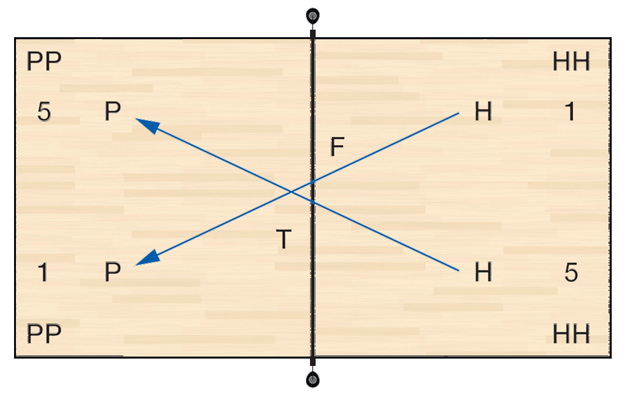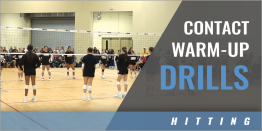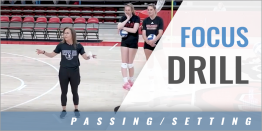| Across the Net Crossfire / Pepper Progression |
| By: Gregory Shell - Assistant Coach - Central Connecticut State University
Originally Published in: Coaching Volleyball Provided by and Copyright: American Volleyball Coaches Association Across the Net Crossfire uses two groups, a passing group and a hitting group. Both groups are divided in half, with half of your Hitters (H) in a line coming into zone 1, and the other half in zone 5 on the same side of the net. The Passers (P) are set up the same way on the other side of the net. There is also a target on the passing side (probably with a ball cart to fill) and a feeder on the hitting side with a full ball cart. See diagram. In the most basic version of this drill, the Hitters in zone 5 are self-tossing and hitting a downball across the net to the Passers in zone 5, while the Hitters in zone 1 are hitting to zone 1. After hitting the downball, the Hitter goes to the end of her own line, or to the end of the other hitting line, however you have decided to structure the drill. The Passer will go to the end of her own line or to the back of the other passing line, as instructed. So as not to stress the target too much, either add extra shaggers for ball management or make sure the hitters alternate, so that more than one pass isn't up in the air at one time. To add variety and a little more reality to the drill, the Feeder can toss the balls for the Hitters; now they are focused not only on hand contact and a high contact point, but on moving to the ball and on getting the ball where they want it to go, even if the set they are hitting is not ideal. They are still working crosscourt, so the swings are fairly simple (unless the toss is terrible, when your hitter may have a bit more work to do). You can run the same drill but instead of hitting crosscourt, the balls are now hit down the line, so zone 5 hits to zone 1, and zone 1 hits to zone 5. We usually start with a short self-tossed piece here, before progressing to hitting a tossed ball - there will be some ugly swings if tosses are not accurate, but it certainly reinforces the need to move not only your feet, but also your hitting shoulder, to the ball. The last progression, Across the Net Pepper, is set up the same, but you will not need a tosser (after the initial ball is entered) or a target. This can be played as a cooperative two- or three-touch game, or as a competitive two- or three-touch game. The ball is entered on a toss, and goes live immediately. If you are playing three-touch, the first contact is passed up and the partner sets, and the initial passer downballs - as the ball crosses the net, both step off and are replaced by the next in line. (Note: It really helps if you script crosscourt or line, especially in the cooperative versions.) The ball is played out until it drops, and another is introduced. The two-touch variety is less gamelike, but really focuses on control of the ball, and stresses both the passer and the hitter - the first touch is passed up, and the second must be downballed. There are a variety of ways to score this game, and you can set up the rotation pretty much any way you want - no matter how you set it up, there should be plenty of good passing reps and great opportunities to work on hand contact and armswings in a changing environment. Enjoy, and Happy Hitting! |








